FCC Process Reform Report
The comments congratulate FCC on its thorough report to improve its procedures and advocated some clarifications and extensions of the recommendations.
Here is a summary of the points made:
- The comments strongly supported the new promise to act in a timely way on petitions but pointed out that this is already a longstanding, but generally ignored, requirement of §1.403. Timely disposition of petitions is key to capital formation for wireless systems that need nonroutine approvals.
- The report recommended grouping questions at the end of NPRMs. The comments suggested the key issues were to group the questions, limit the number to a manageable amount, and actually number them. The report gave examples from Industry Canada and Ofcom “consultations” where a modest number of questions were grouped and numbered.
- The report suggested “continue to engage with other agencies to develop best practices for rulemaking”. The comments endorsed this concepts and suggested it be broadened to include foreign telecom regulators like the above mentioned Ofcom and IC as well as innovative entities like the North Dakota Supreme Court that issues its opinions in hypertext. It pointed out that in the ex parte rulemaking FCC limited its comparison with other agencies to FTC, and that agencies like EPA, NRC, and FAA might be closer to at least FCC’s technical jurisdiction practice.
- The report urged “better tracking of complaint data”. Following previous discussion here of emerging interference, the comments discussed several cases of large delays in handling such issues and suggester more reporting and public interaction on new interference mechanisms to determine which need timely regulatory actions and which can be handled with benign neglect.
- On the recommendation to “increase technical inputs early in rulemaking”, the comments pointed out the previous IEEE-USA recommendations on supplementing the TAC with a paid advisory committee without conflicts of interest, as EPA and NRC have, that can interact on pending policy issues in a timely way - complementing the functions of the TAC. IEEE-USA had recommended that this be a joint FCC/NTIA committee that could serve both agencies and have security clearances to handle classified issues such as GPS interference and susceptibility. It also recommended that both FCC and NTIA budget for support from National Academy of Science’s National Research Council (NAS/NRC), Federally Funded Research and Development Centers (FFRDCs)e.g. MITRE Corp., Rand Corp., and Aerospace Corp., in support of technical policy issues that the in-house staff do not have experience with. This would follow the practices of NRC and EPA with new technical issues.
- Finally it pointed out that even though §7 was passed 30 years ago FCC has no implementing policies and rules. It urged that FCC either adopt such now or tell Congress that §7 needs repeal or modification. (Although it would be odd to take 30 years to figure that out!)
DoD Electromagnetic Spectrum Strategy Release
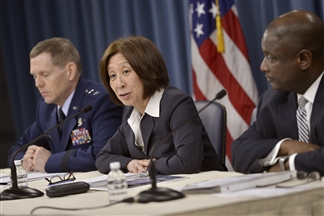
Teri Takai, center, the Defense Department's chief information officer, Air Force Maj. Gen. Robert E. Wheeler, left, the department's deputy chief information officer, and Frederick J. Moorefield Jr., right, the department's director of spectrum policy and programs, brief reporters on the department's release of its electromagnetic spectrum strategy. DOD photo by Glenn Fawcett .
On Thursday February 20, 2014 “The Department of Defense announced … the release of its Electromagnetic Spectrum Strategy (EMS) to increase available spectrum in order to meet growing demand from the commercial wireless industry while maintaining critical military capabilities.” CTIA responded almost immediately with this statement from Steve Largent:
“We agree with the DoD's conclusion that its systems must become more spectrally efficient, flexible and adaptable. In fact, these are good goals for all federal users, and CTIA looks forward to engaging with the DoD, NTIA and the whole federal user community to see how the wireless industry can help them achieve their mission objectives while ensuring that commercial users have access to the spectrum our members need to meet consumer demand and drive economic growth and innovation.”
The first thing we noticed, sort of the “elephant in the room”, was that the report that was released was dated “SEP 11 2013”:
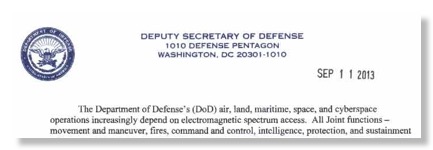
and was actually titled “Electromagnetic Spectrum Strategy 2013 - A Call to Action”. Why this 2013 report was released more than 3 months after it was signed and dated in an unclassified form is a mystery not mentioned in any trade press coverage. Our best guess was that there are a behind the scenes disagreement somewhere within in the Executive Branch or between FCC and NTIA. CTIA’s prompt response indicates that they were not waiting for the report to appear on the DoD website.
The following diagram from the report shows that DoD has a better handle on quantifying its needs than CTIA does with its famous “flag chart”: DoD quantifies its mobile communications needs in terms of “Mbps per 5000 Military Members” and shows how this has increase dramatically and will continue to do so. The cellular industry, by contrast, denominates its requirements solely in terms of MHz, independent of technical developments and the gains due to infrastructure growth/cell splitting. Now presumably the industry projection included expected gains from technical efficiency improvements and infrastructure growth, but these are never itemized nor are they updated. For example, due to the availability of new technology in the past 3 years, has the spectrum requirements in the “flag chart” increased or decreased? The real requirement for both DoD and the cellular industry is really denominated in data rate as DoD has done in this report. Kudos to DoD.
Getting to the actual report, it fully supports the reallocations ordered by President Obama in June 2010 to get 500 MHz of new spectrum to cellular carriers from existing federal and non-federal spectrum. No great surprise.
A key section says:
DoD systems must become more spectrally efficient, flexible, and adaptable, and DoD spectrum operations must become more agile in their ability to access spectrum in order to increase the options available to mission planners. (Spectrum efficiency is the use of the minimum amount of EMS resources necessary to ensure maximum operational effectiveness in fully accomplishing the required mission while taking all practicable steps to minimize impacts to other systems in the EME.Spectrum flexibility and adaptability is the capability of a spectrum-dependent system (SDS) to exploit various opportunities to access spectrum – e.g., multi-band operation, increasing the ability to share spectrum with other systems (domestic or foreign, federal, or non-federal), becoming more tolerant of interference. Agile spectrum operations will enable DoD systems to utilize their flexibility and adaptability to achieve mission success in rapidly changing EMEs.)
In the past, spectrum was a “free good” (except for minor NTIA regulatory fees) for DoD and other federal users and there was no incentive to be efficient as long as enough spectrum was obtainable. Top level attention to spectrum efficiency is thus a good move in the right direction and hopefully NTIA will extend this to other agencies. But the focus in this discussion is making military systems more agile so they can access more bands as they operate around the world.
What is missing is what NTIA Chief Larry Stickling said a few months ago, “sharing is the new normal”. While DoD is implementing White House orders to make spectrum available for the politically (and economically) powerful cellular industry, will DoD be more receptive to sharing proposals in other bands and be less likely to automatically stonewall? We have repeatedly pointed out that 225-400 MHz military use generally is very different geographically than civil use (San Diego being a notable exception) and that with new technology it could be made available to civil users on an “interruptible spectrum” basis, not unlike what is being considered for the 3550-3650 MHz band. Will DoD be receptive to such creative sharing proposals? We hope so but the new policy statement is silent on the issue.
We hope DoD and NTIA will clarify the issue of what is meant by “sharing is the new normal” and specifically whether this is a one way street with respect to military spectrum use in US territory.

Will spectrum sharing in US territory be a one way street for DoD?
UPDATE
See http://www.marcus-spectrum.com/Blog/files/SpecMeasCorr414.html
DySPAN 2014 Spectrum Policy Tutorial
Your blogger will be presenting a tutorial on “A Hands-on Approach to Spectrum Regulation for Innovative Wireless Engineers” at the IEEE Dynamic Spectrum Access Networks Conference (DySPAN2014) in McLean, VA on Tuesday April 1, 2014 at 1:30 - 5 PM alongside Mr. Nelson Pollack, the former Air Force member of IRAC who has much experience in federal spectrum management issues as well as ITU matters.
Here is the summary:
National and international spectrum policy issues are key factors in the practical implementation of innovative wireless technology as spectrum access is highly regulated in all countries. This course, taught by two long time experts in spectrum policy, will review what an engineer working on cutting edge issues needs to know about what is permitted, what may be permitted, and working to push the boundaries of spectrum policy to enable new technology. The focus will be on international spectrum policy and US national policy for both private sector use and federal government use.
Registration information is here.
Hope to see you there!
FM Broadcast -> 700 MHz LTE Interference Problem Reveals Basic FCC Spectrum Policy Problems
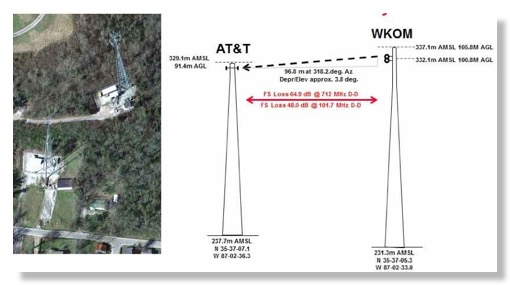
On June 25, 2013 our friends at CommLawBlog published a surprising post that has not received much attention. It was entitled “Harmonic Convergence? FM Interference to 700 MHz LTE Service” and was authored by Peter Tannenwald.
The post starts:
The introduction of different species into an established ecosystem tends to be a dicey proposition. Almost invariably, co-habitation requires the sharing of scarce resources. And more often than not, the different species approach the whole sharing thing in different, not entirely compatible, ways. The result: occasional dissatisfactions and frustrations – leading to occasional inter-species frictions and fisticuffs.
Take the RF spectrum ecosystem, for example.
Most inhabitants of the spectrum have historically figured out ways to coexist in relative peace (at least for the most part) – thanks largely to the fact that the potential impact of one service on another has been taken into account in the frequency allocation process. But as the demand for spectrum increases, and every little niche is filled up, it is becoming more difficult to avoid inter-service conflicts. And sure enough, the introduction of a recent new species – 700 MHz wireless systems using LTE equipment – seems to be causing some unexpected problems.
The post goes on to describe an emerging problem of interference from FM broadcast stations to 700 MHz cellular base stations nearby. A search of the FCC website on this issue found no public documents on the FCC’s voluminous website dealing with this issue. Fortunately Google found several non-FCC documents published after Mr. Tannenwald’s breaking post.
Barry Mishkind at The Broadcasters' Desktop Resource (BDR) published a report on June 28, 2013 that is linked to a detailed technical discussion of the issue. The public trail of this event appears to begin on 6/19/13 with the issuance of a Notice of Violation* by the FCC’s Enforcement Bureau’s New York District Office to WKZE-FM in Salisbury CT. The NOV alleges that their signal on 98.1 MHz had an 8th harmonic at 784.8 MHz that was causing interference to a VZW base station located approximately 500 feet away. The NOV cited 73.317(a):
(a) FM broadcast stations employing transmitters authorized after January 1, 1960, must maintain the bandwidth occupied by their emissions in accordance with the specification detailed below. FM broadcast stations employing transmitters installed or type accepted before January 1, 1960, must achieve the highest degree of compliance with these specifications practicable with their existing equipment. In either case, should harmful interference to other authorized stations occur, the licensee shall correct the problem promptly or cease operation. (Emphasis added.)
A major issue here is whether the above clear rule take precedent over the Commission’s general “first in time, first in right philosophy”** that is stated neither in the law nor as a general codified rule. We will leave it to our legal friends to parse case law on this issue.
Clearly the NAB crowd and the CTIA crowd have a major difference in viewpoint here. NAB’s past quixotic attempts to require all cell phones to have FM receivers certainly is not helping these industry giants’ mutual relationship, especially at this time of incentive auction focus by all.
We have not seen any public statements from the cellular community on this issue, so Scott Baxter’s comprehensive 10/13 presentation to the Association of Federal Communications Consulting Engineers, a mainly broadcast engineering group, is the most definitive discussion of the technical issue on the public record. (Scott’s usual clients appear to be mostly wireless firms.)
It is unclear what the technical problem here really is, although there seems no controversy that the FM transmitter in question meets the numeric out of band emission limits of § 73.317(d):
(d) Any emission appearing on a frequency removed from the carrier by more than 600 kHz must be attenuated at least 43 + 10 Log10 (Power, in watts) dB below the level of the unmodulated carrier, or 80 dB, whichever is the lesser attenuation.
Several possible hypotheses:
- This out of band emission level of § 73.317(d) is not adequate to protect 700 MHz LTE base stations x meters away.
- The usual measurement procedure for determining this emission limit may focus too much on the power that goes to the antenna and not enough on incidental leakage from the transmitter cabinets that might have inadequate shielding in some models. (This is consistent with observations in the Baxter briefing.)
- The emission limit is adequate, but loose metal connections in or near the cellular antenna structure generate harmonics from the strong FM signal a few hundred feet away just as intermodulation products are generated in strong electromagnetic fields when there is a dense concentration of transmitters such as Mt. Wilson, CA and Sandia Ridge, NM.
- The cellular base station receivers may be inadequately filtered/shielded and subject to desensitization in strong fields from the FM transmitter hundreds of MHz away. Despite years of talk, FCC still has no general policy on receiver performance issues.
- The IEEE-USA harmful interference white paper, released in July 2012, urges FCC to clarify the issue of “minimum protection distance” with respect to all interference issues since generally any receiver will get interference if it gets too close to a transmitter. While there are clear precedents for a few cases such as personal computers near TV receivers and UWB devices near PCS cell phones, FCC has no general position on this issue or even a process to determine minimum protection distance. Thus the cellular interests will say there is should be no interference at 500 feet and the broadcaster will disagree.
- Rather than keeping this issue off the public agenda, as it has so far except for the difficult to find NOV, FCC should be engaging industry experts in an open and transparent way. This highlights one of the problems of the FCC’s Technological Advisory Committee (TAC): it is not set up to handle this type of problem as it consists mostly of technical policy managers of key players, not the technical experts in the area (National Academy of Engineering members and IEEE Fellows are rare) and meets infrequently. Thus there is no indication of any TAC involvement to date as this problem threatens LTE roll outs. Note that another IEEE-USA 2012 product, “Position Statement on Improving U.S. Spectrum Policy Deliberations in the Period 2013-2017” addressed the issue of improving advisory function based on best practices of other regulatory agencies with technical jurisdiction:
FCC and NTIA should supplement their existing Technological Advisory Council (TAC) and Commerce Spectrum Management Advisory Committee (CSMAC), which consist mainly of representatives of major communications firms, with a new advisory committee that serves both agencies and focuses on independent review of options for resolving spectrum conflicts and identifying outdated policies. The new group should be modeled on the EPA Science Advisory Board and the NRC Advisory Committee on Reactor Safeguards and members should have the necessary security clearances to deal with issues involving classified federal government spectrum users, if so requested.
- “Emerging interference” has been a recurring topic in this blog. In our dynamic wireless industry it is not surprising the new and unexpected interference mechanism appear in practice and need timely attention, for the bigger they become they usually become harder to solve. But for decades FCC has had no mechanism for dealing with emerging interference issues. Thus the police radar detector interference to VSAT receivers took more than a decade to resolve (the official FCC records “fuzzify” the starting date of the problem) and the “cellular booster” issue took 6+ years. FCC needs a generic and transparent problem for identifying such issues promptly and for engaging the public on which need urgent attention and which deserve “benign neglect”. For example, home TV antennas with built-in amplifiers, rare prior to DTV, are a recurring source of interference to TV and other services at a modest rate and it is marginal whether the issue needs regulatory attention at this time. But how many top FCC managers and 8th Floor residents are aware of this and other emerging issues?
- This is closely related to the reason why the Commission’s Spectrum Policy Task Force originally raised the issue of “interference temperature” a decade ago. The goal was to define better what environment systems should expect in practical operation. It may well be that the designers of these base station never considered an environment with a strong FM signal present from a nearby transmitters. But the NOI/NPRM in Docket No. 03-237 was so poorly and confusingly written that FCC closed the docket in 2007 and has never expressed any further interest in the issue. Whether or not interference temperature is ever used as a basis for allowing more unlicensed use, quantifying expectation really would help incumbents and would allow timely resolution of controversies such as this FM/LTE one.
Your blogger has filed a FOIA request with FCC seeking all correspondence on this issue with outside parties relating to the NOV. It does not seek internal FCC documents that have various FOIA exemptions. These documents will be posted here as soon as they are available. However, unless they embarrass Rupert Murdoch, that probably won’t be soon.
* The NOV URL given is from the FCC website, BUT we have found no way to get there unless you happen to have bookmarked the URL for Notices of Violation and Notices of Unlicensed Operation issued by Field Offices or the Enforcement Bureau’s old home page - no longer linked to the main FCC website.
** - The “newcomer” policy dates back to Midnight Sun Broadcasting Co., Memorandum Opinion and Order, 11 FCC 1119 (1947), in which the Commission held a broadcaster responsible for resolving interference caused by its new facilities to other preexisting facilities in close proximity. See FCC 13-115 at para. 4 and fn. 7
UPDATE
In a tweet responding to this post, Brett Glass hypothesized “FM could be hitting inadequately shielded IF stages in LTE equipment.”
Sharing Federal Spectrum - New Report

Of particular interest to your blogger was Section VII. Facilitating Sharing: Incentivizing Federal Users. Federal users currently pay a small fee that supports the costs of the NTIA spectrum office. But the fee structure is not well known and is about $150/NTIA assignment. An assignment might be a 25 kHz channel in one city, a communications satellite, or a nationwide system. The fee is the same as NTIA has never been able to work out with the IRAC a better system.
Here is the description of Section VII from the executive summary of the report:
It is widely accepted that until Federal users internalize the costs associated with their spectrum use, they have little incentive to use spectrum more efficiently or support proposals to share their spectrum. If federal users paid for spectrums use, they would internalize the cost associated with holding spectrum assignments that prevent other productive uses of the frequencies.
Recognizing the costs of spectrum through a federal fee would incentivize federal users to adjust their usage to reduce costs. While there are limitations to a fee-based approach, it would require government users to incur some cost for spectrumusage. By imposing a spectrum based fee, the cost of spectrum based services for federal users will reflect the use of this scarce resource. The question is: what should the fee be tied to?
Consistent with the principle that government spectrum users should consider the forgone economic value of spectrum deployed for their services, we suggest that a federal user fee should be based on the commercial value of spectrum. By tying the fee for federal spectrum to spectrum’s commercial price, federal users would be incurring the foregone economic value or opportunity cost of the spectrum in deploying these federal services. A fee based on the commercial value of spectrum would require that federal users at least acknowledge this opportunity cost of the spectrum use and publicly argue that the value of their use of the spectrum exceeds this opportunity cost.
FCC §15.9, Drones & Privacy
§ 15.9 Prohibition against eavesdropping.
Except for the operations of law enforcement officers conducted under lawful authority, no person shall use, either directly or indirectly, a device operated pursuant to the provisions of this part for the purpose of overhearing or recording the private conversations of others unless such use is authorized by all of the parties engaging in the conversation.
The above is the current text of 47 C.F.R. 15.9 that limits the use of unlicensed devices for “eavesdropping”. Not being a subscriber to WestLaw or Lexis, I can’t readily tell you how long this language has been in the FCC Rules, but I am pretty sure it predates my arrival at FCC in 1979. This section not only limits the use of unlicensed devices for eavesdropping, but also gives the FCC an excuse to deny equipment authorization to them and thus to keep them off the open market.
The possibly widespread use of drones raises all sorts of privacy concerns. While your blogger is a “card carrying ACLU member”, something that really annoyed FBI and other intelligence community employees he interacted with while at FCC, this post does not deal with surveillance that is explicitly authorized by law. Rather it deals with surveillance for commercial purposes or just invading the privacy of your neighbors. (Federal operation of drones is not subject to any FCC jurisdiction in any case, although state and local police use is.)
A simple first step FCC could take would be to extend the long-standing provisions of §15.9 to include imagery from drones, thus keeping cheap unlicensed drones out of Radio Shack and large scale consumer use. If you want to get imagery from drones, the least you can do is get a radio license.
Part of a cellphone jammer ad

From a Wi-Fi Jammer Ad
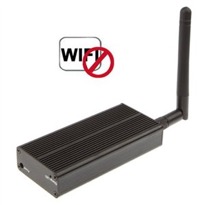
UPDATE
This CNN piece about drones tricking Wi-Fi to get your private information in a “man in the middle attack” may be another reason to limit drone access to unlicensed bands.
"Aux Armes" Netoyens:
End the War on Millimeter Wave Technology

The chorus of the Marseillaise, the French national anthem begins with:
Which translate toAux armes, citoyens,
Formez vos bataillons,
Marchons, marchons !
To arms, citizens,
Form your battalions,
Let's march, let's march!
(While I lived in Paris, I often walked by Eugène Delacroix’s masterpiece Liberty Leading the People [La Liberté guidant le peuple] while visiting the Louvre. [Oddly, the painting also made a rare overseas trip to Tokyo in 1999 when I was living there and was the hit of the town during its visit.] The words of the Marseillaise and the picture describe events and the initial idealism of the French Revolution. But while the”armes”/“arms” in the above lyrics means weapons, what is needed in the context of this post is the use of human arms to write to FCC and advocate constructive action.)
The commentators of Fox News repeatedly comment on the “war on coal” and the “war on religion”. Well, the “war on millimeter (mmW) wave technology” at FCC is just as real and easier to document, although it is no doubt unintentional. There are 3 proceedings at FCC that document FCC’s present disinterest/apathy towards commercial use of cutting edge microwave technology, even as our national competitors advance in this area.
While not exactly an issue comparable to the causes of the French Revolution, the current situation of US regulation >95 GHz needs the urgent attention of “netoyens”, especially researchers and firms dealing with millimeter wave technology. While the FCC Rules have spectrum allocations up to 275 GHz, the lack of “service rules” beyond 95 GHz (with the minor exception of certain amateur radio and ISM bands) makes regular commercial licensed or unlicensed mmW use impossible. This in turn greatly complicates capital formation for such technology because VCs can easily find other technology to invest in that does not involve making a prominent FCBA member a member of your family for several years and paying his children’s college tuition while at the same time the entrepreneur has no access to market and bleeds red ink.
Sadly, with the exception of the IEEE 802 LAN/MAN Standards Committee (the techies behind Wi-Fi standards), Boeing, and the more obscure (at least in FCC circles) Battelle Memorial Institute and the rather obscure Radio Physics Solutions, Inc., no commercial interests have filed comments with FCC on 3 key issues blocking capital formation for technology above 95 GHz and by extension hindering US competitiveness in advanced radio technology.
The 3 dockets involved are:
- Docket 10-236 which as previously reported here was supposed to encourage experimentation had the apparently unintended effect of complicating millimeter waver research by forbidding, for the first time and without an explanation, all experimental licenses in bands with only passive allocations independent of whether there was any impact. Many mmW bands have only passive allocations and it is difficult a and expensive to avoid them in initial experiments with new technology and it is not important if there is no passive use near the experiment than could get interference. Since the text of the Report and Order contradicts itself on this issue, the simplest explanation is that a sentence was put in the wrong section. Your blogger filed a timely reconsideration petition when he noticed this 2 days before the deadline and that had been supported by Battelle and Boeing and has been opposed by none. But FCC doesn’t necessarily react in a timely way, specially when incentive auctions are very distracting and staffing is low, unless there are multiple expressions of concerns, preferably from corporate America.
- Docket 13-259 deals with the IEEE-USA petition seeking timely treatment of new technology proposals for this green field spectrum >95 GHz under the terms of 47 USC 157, although any clear statement from FCC on how to get timely decisions on such spectrum would be useful.
- Docket 13-84 has proposed updating the Commission’s RF safety rules. The rules currently only have numeric limits up to 100 GHz - the upper limit of the standard they were based on when they were last updated almost 2 decade ago - but the new proposals are silent on numeric limits above 100 GHz even though the standard that is now the base of the regulations now goes to 300 GHz! This lack of a specific safety standard above 100 GHz adds even more to the regulatory uncertainty of those interested in mmW technology. With today’s mmW technology, the specific numeric standard doesn’t really matter much because exposures will be low. But this proposal to leave ambiguity for mmW systems can be very damaging. Battelle has proposed one way to deal with a specific standard. Others interested in mmW technology should either support it or propose an alternative.
So netoyens, Aux armes! The time has come to take your arms (and the attached hands) and write to FCC urging timely action on these three dockets to level the playing field for mmW technology and help US competitiveness.
As a public service, Marcus Spectrum Solutions LLC will draft comments in these 3 dockets for any US manufacturer of mmW equipment dealing with the issues above at no charge to reflect whatever your viewpoints are.
(Note MSS is not licensed to practice law so this offer does not involve the practice of law. Let’s discuss what your viewpoints are and we will draft a document for review by your legal staff.)
Japanese 120 GHz system used at 2008 Beijing Olympics
German 237 GHz System exceeding 100 Gbits/s
( An experiment probably not permitted under the terms of the recently revised §5.85(a))
Chrysler Superbowl Ad on “American Pride” - MSS believes that advanced wireless technology is just as American as automobile production in Detroit. US can compete if FCC doesn’t slow innovation!
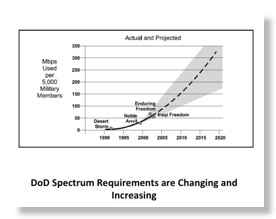

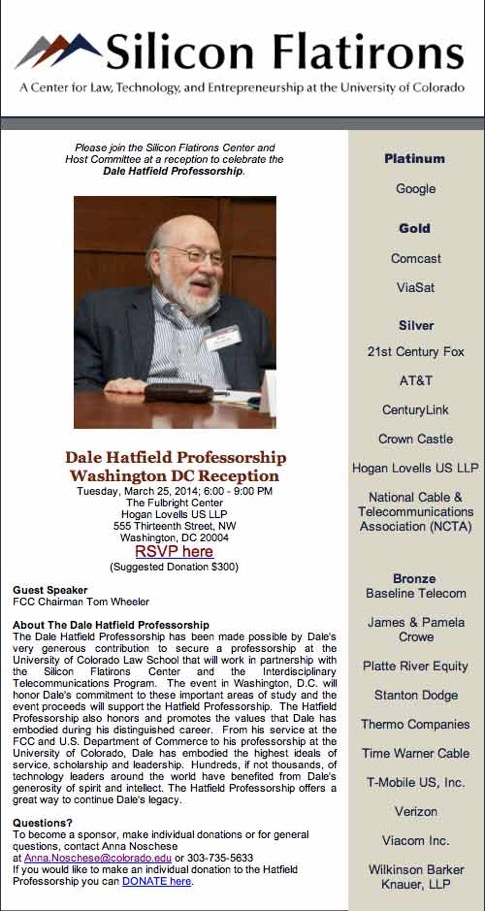
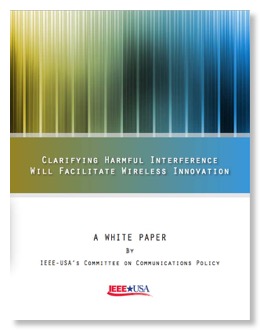




![Validate my RSS feed [Valid RSS]](valid-rss-rogers.png)

